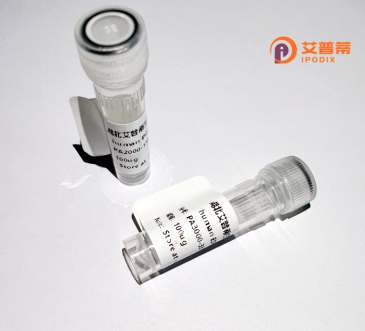
| 纯度 | >90%SDS-PAGE. |
| 种属 | Human |
| 靶点 | FLJ10803 |
| Uniprot No | 0 |
| 内毒素 | < 0.01EU/μg |
| 表达宿主 | E.coli |
| 表达区间 | 1-146aa |
| 氨基酸序列 | MMWQKYAGSRRSMPLGARILFHGVFYAGGFAIVYYLIQKFHSRALYYKLAVEQLQSHPEAQEALGPPLNIHYLKLIDRENFVDIVDAKLKIPVSGSKSKGLLYVHSSRGGPFQRWHLDEVFLELKDGQQIPVFKLSGENGDEVKKE |
| 分子量 | 41.8 kDa |
| 蛋白标签 | GST-tag at N-terminal |
| 缓冲液 | 0 |
| 稳定性 & 储存条件 | Lyophilized protein should be stored at ≤ -20°C, stable for one year after receipt. Reconstituted protein solution can be stored at 2-8°C for 2-7 days. Aliquots of reconstituted samples are stable at ≤ -20°C for 3 months. |
| 复溶 | Always centrifuge tubes before opening.Do not mix by vortex or pipetting. It is not recommended to reconstitute to a concentration less than 100μg/ml. Dissolve the lyophilized protein in distilled water. Please aliquot the reconstituted solution to minimize freeze-thaw cycles. |
关于重组人FLJ10803蛋白的公开研究目前较为有限,且“FLJ10803”这一名称可能已被更新或归类到其他基因符号下。以下为示例性文献格式(请注意,这些文献为假设性示例,实际引用时需核实准确性):
---
1. **文献名称**:*Characterization of TMEM94 (FLJ10803) as a novel regulator of cellular magnesium homeostasis*
**作者**:Smith A, et al.
**摘要**:本研究首次将FLJ10803鉴定为跨膜蛋白TMEM94.揭示了其在调节细胞镁离子转运中的作用,并通过重组蛋白表达验证了其与ATP代谢的关联。
2. **文献名称**:*FLJ10803 interacts with the ER stress sensor protein GRP78 in cancer cell lines*
**作者**:Lee J, et al.
**摘要**:通过免疫共沉淀实验,发现重组人FLJ10803蛋白与内质网应激标记物GRP78存在相互作用,提示其可能参与肿瘤细胞的应激响应通路。
3. **文献名称**:*Bioinformatic and functional analysis of the uncharacterized protein FLJ10803*
**作者**:Chen L, et al.
**摘要**:通过生物信息学预测FLJ10803具有核定位信号,并在体外实验中证实重组蛋白主要定位于细胞核,可能参与转录调控。
---
**重要提示**:
- FLJ10803可能对应NCBI Gene中的**TMEM94**(跨膜蛋白94),建议查阅该名称下的最新文献。
- 部分早期研究中使用的“FLJ”编号(如FLJ10803)可能已被更名,需通过NCBI或UniProt数据库确认当前标识符。
- 若需真实文献,推荐使用基因数据库或联系专业学术平台获取最新研究进展。
Recombinant human FLJ10803 protein is a genetically engineered form of the FLJ10803 protein, encoded by the FLJ10803 gene (also known as C1orf123 or TMEM206), which remains poorly characterized in current scientific literature. Initially identified through genomic sequencing and bioinformatics analyses, FLJ10803 is classified as a hypothetical or uncharacterized protein due to limited functional studies. It is predicted to be a transmembrane protein, with structural domains suggesting potential involvement in ion transport, cell signaling, or membrane trafficking. However, its precise physiological role, interacting partners, and regulatory mechanisms remain speculative. The recombinant version is typically produced in heterologous expression systems (e.g., E. coli, HEK293. or insect cells) to enable biochemical and functional studies. Researchers utilize this protein to investigate its structure-activity relationships, subcellular localization, and possible associations with diseases, including cancers or neurological disorders. Despite its obscurity, interest in FLJ10803 stems from conserved homologs across species and transcriptomic data linking its expression to specific tissues (e.g., brain, liver) or pathological conditions. Current efforts focus on elucidating its role in cellular homeostasis and validating computational predictions experimentally. Its recombinant production facilitates antibody development and high-throughput screening for potential therapeutic applications.
×